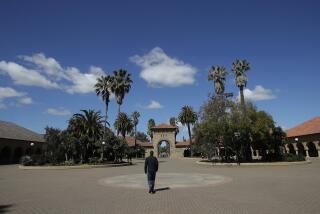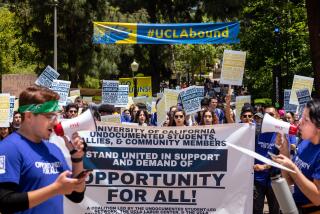The Real Numbers Offer Nothing to Cheer About
A yearly ritual is taking place since the adoption in 1995 of SP-1 and SP-2--the University of California regulations banning affirmative action--and the passage in 1996 of Proposition 209--the initiative that overturned affirmative action statewide.
UC public relations officials lead a cheer on how many African Americans and Latinos are applying to each of the UC campuses. Impressive statistics are rolled out. The general public is left with the impression that anti-affirmative action measures have had no effect on minority enrollments at our public, tax-supported institutions of higher education.
What these cheerleaders don’t tell you, however, is that minority applications provide only a part of the story of what is happening at UC. In order to show the true impact of SP-1 and SP-2, one must examine applications, admissions and enrollments. To give the full picture, what UC officials should be telling the state Legislature and the California public is how admissions and overall attendance rates have been negatively affected by these regulations.
First, let’s get our terms straight. Acceptance rates are the percentage of students who are admitted from the number who apply. Attendance rates are the percentage of students who actually enroll out of those who are accepted.
Why is it important to keep these distinctions in mind? If minorities, and Latinos specifically, are an ever-increasing percentage of California high school graduates, we can naturally assume that Latino applications will grow. What really matters, then, are the acceptance and enrollment rates. Yet when you look at the actual number of applications, admissions and enrollments at UC, the figures tell a drastically different story.
According to an analysis by the Tomas Rivera Policy Institute, acceptance rates for Latinos have dropped since 1997 by 38% at UCLA, nearly 43% at UC San Diego and 38% at UC Berkeley. Only UC Riverside maintained a somewhat level admission rate for Latino students. For African American students, the situation was just as dismal. African American student acceptance rates fell by 37% at UCLA, 43% at Berkeley and an incredible 64% at UC San Diego. Systemwide, the minority acceptance rate dropped 24%.
It is true that there have been modest increases in minority enrollment systemwide. Latino enrollments climbed by 100 students at the eight UC campuses between 1997 and 1999 (although African American student enrollment actually dropped by 160 students for the same time period).
How does one then explain the difference between acceptance rates and minority enrollments? The answer is simple: There are more Latino and African American students applying.
One thousand more African American and Latino students applied for admissions to the UC in 1999 than in 1997. On some campuses, the increase in applications was enough to offset the higher minority rejection rates. In others the higher rejection rates, plus the decision by minority students not to attend that particular campus, saw an actual decline in African American and Latino presence. Half of the UC campuses (Berkeley, Davis, UCLA and San Diego) have fewer Latino freshmen enrolled now than they did two years ago. Five of the eight UC campuses have fewer African American students now than in 1997. According to our institute’s analysis, if acceptance rates had remained the same in 1999 as they were in 1997, 5,382 more Latino and African American students would be attending the UC.
It should be troubling to all that an institution devoted to the pursuit of objective knowledge is apparently not facing up to the tremendous impact that the anti-affirmative action regulations have had on their student bodies. Some campuses are doing better at acceptance rates for minorities. What accounts for these differences? What exemplary programs are in place at these campuses that can be duplicated at others? We need to find out.
California is destined to become the first mainland state with a great majority of its population of minority background. In less than a generation, Latinos in California will outnumber white non-Latinos. What does it mean when the state’s premier educational institution is not reflecting the state’s demographic diversity in preparing the next generation of leaders, scholars and corporate executives? Let’s stop the cheerleading and ask the University of California to take an honest look at what SP-1 and SP-2 have wrought.
More to Read
Sign up for Essential California
The most important California stories and recommendations in your inbox every morning.
You may occasionally receive promotional content from the Los Angeles Times.










